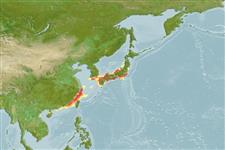>
Gobiiformes (Gobies) >
Gobiidae (Gobies) > Gobiinae
Eponymy: Professor Cornelius Jan van der Horst (1889–1951) was a Dutch zoologist who moved to South Africa (1928) and became Head of the Zoology Department, Witwatersrand University, Johannesburg. [...] (Ref. 128868), visit book page.
Environment: milieu / Klimaatzone / Diepte / distribution range
Ecologie
marien demersaal; diepte 60 - 123 m (Ref. 75057). Subtropical
Northwest Pacific: China and Japan (Ref. 75057).
Grootte / Gewicht / Leeftijd
Maturiteit: Lm ? range ? - ? cm
Max length : 4.0 cm SL mannelijk / geslacht onbekend; (Ref. 75057)
Korte beschrijving
Determinatiesleutels | Morfologie | Morfometrie
Dorsale stekels (totaal) : 7; Dorsale zachte stralen (totaal) : 11 - 12; Anale stekels: 1; Anale zachte stralen: 11. This species is distinguished from its congeners by the following set of characters: 11-12 (usually 11) segmented rays on second dorsal fin; 26-27 (-30?) longitudinal scale count; predorsal scales absent; 8 transverse scales from origin of second dorsal fin backward and downward to anal-fin base; pectoral-fin base naked; anterior 3 spines of first dorsal fin usually elongate and filamentous, extending posteriorly to base of first, second or third segmented ray of second dorsal fin; connecting membrane between innermost rays well developed; when fresh: irregular shaped yellow (pale in preservative) markings on cheek and operculum, oblique narrow yellow line from posterior end of eye to nape, small bright yellowish red spot on center or anteroventral part of operculum, ca. 9 narrow yellow vertical bars on body, distal tip of first dorsal fin vivid red, and a narrow yellow longitudinal band on middle of anal fin (Ref. 75057).
Levenscyclus en paargedrag
Maturiteit | Voortplanting | Paaien | Eieren | Fecunditeit | Larven
Eschmeyer, W.N. (ed.), 2006. Catalog of fishes. Updated database version of April 2006. Database dump. Catalog databases as made available to FishBase in April 2006. (Ref. 56787)
Status op de Rode Lijst van het IUCN (Ref. 130435: Version 2025-1)
Gevaar voor de mens
Harmless
Gebruik door de mens
Tools
Speciale rapporten
Download XML
Internetbronnen
Estimates based on models
Fylogenetische diversiteitsindex (Ref.
82804): PD
50 = 0.5000 [Uniqueness, from 0.5 = low to 2.0 = high].
Bayesian length-weight: a=0.00955 (0.00355 - 0.02566), b=3.03 (2.80 - 3.26), in cm total length, based on LWR estimates for this (Sub)family-body shape (Ref.
93245).
Trofisch niveau (Ref.
69278): 3.2 ±0.3 se; based on size and trophs of closest relatives
Weerstandsvermogen (Ref.
120179): Hoog, minimale populatieverdubbelingstijd minder dan 15 maanden (Preliminary K or Fecundity.).
Fishing Vulnerability (Ref.
59153): Low vulnerability (10 of 100).
🛈
